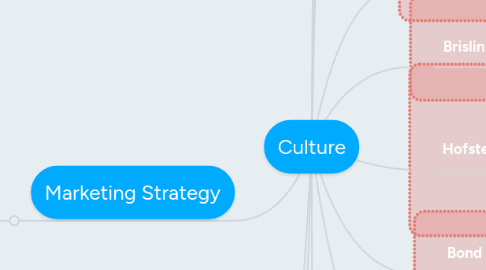
1. Culture is...
1.1. Learned
1.1.1. Enculturation
1.1.2. Acculturation
1.2. Inculcated
1.3. Social Phenomenon
1.4. Gratifying
1.5. Adaptive
2. Marketing Strategy
2.1. Consumer Behavior
2.1.1. Language
2.1.2. Demographics
2.1.3. Values
2.1.4. Nonverbal Communication
2.1.4.1. Space
2.1.4.1.1. Size
2.1.4.1.2. Personal Space
2.1.4.2. Symbols
2.1.4.2.1. Colors
2.1.4.2.2. Animals, numbers, music, etc.
2.1.4.3. Time
2.1.4.3.1. Monochromatic
2.1.4.3.2. Polychromatic
2.1.4.4. Friendship
2.1.4.4.1. Rights and obligation
2.1.4.5. Agreements
2.1.4.5.1. Legal systems vs friendship
2.1.4.5.2. Signing vs handshake
2.1.4.5.3. Signals
2.1.4.5.4. Previous vs. fixed or granted prices
2.1.4.6. Things
2.1.4.6.1. Attachment to things
2.1.4.6.2. Appropriate gift
2.1.4.7. Etiquette
2.1.4.7.1. Way to sit, speak, look, eat
2.1.4.7.2. Greeting, business cards, yes-no meaning
2.1.4.7.3. Hugging and kissing
2.1.4.7.4. Eating habits
3. Cultural Values
3.1. Instrumental
3.2. Terminal
4. Subculture
4.1. Age
4.2. Religion
4.3. Race
4.4. Income
4.5. Nationality
4.6. Gender
4.7. Family type
4.8. Occupation
4.9. Geographic region
4.10. Community
5. Hall
5.1. High Context
5.2. Low Context
6. Riesman
6.1. Inner directed
6.2. Other directed
6.3. Tradition directed
7. Brislin
7.1. Individualistic
7.2. Collectivistic
8. Hofstede
8.1. Individualism/Collectivism
8.2. Uncertainty avoidance
8.3. Power distance
8.4. Masculinity/Femininity
9. Trompenaars & Hampden-Turner
9.1. Rules vs. Relationships
9.2. Group vs Individual
9.3. Feelings expressed
9.4. Involvement
9.5. Accorded Status
10. Bond
10.1. Long-Term versus Short-Term Orientation
11. Minkov
11.1. Indulgence vs Restraint
11.2. Pragmatism - Normative
11.3. Monumentalism vs Flexumility
12. Social Class
12.1. Socioeconomic factor
12.1.1. Occupation
12.1.2. Education
12.1.3. Ownership
12.1.4. Income
12.1.5. Heritage
12.2. Social standing
12.2.1. Upper class
12.2.2. Middle class
12.2.3. Working class
12.2.4. Lower class
12.3. Unique behaviors
12.3.1. Preferences
12.3.2. Purchases
12.3.3. Consumption
12.3.4. Communication
